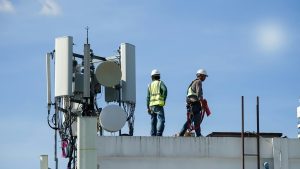With budgets reportedly coming back up for wireless and wireline projects at the big three carriers, there was cautious optimism among the general contractors on the panel View From the Field: The Contractors Perspective during NATE UNITE, held last week in Raleigh, N.C.
“The next three-year spend for two of the three big carriers is bigger than I’ve seen in my 25 years, and that’s wireless as well as wireline,” said Scott Pomykalski, Executive Vice President of Strategic Initiatives at NextEdge.
An increase in tower capex can’t come soon enough for PCI Globalcom, which is still reeling from laying off 70 percent of its workforce earlier this year, according to Michael Graham, President & CEO at PCI GlobalCom, which performs cellular, microwave and DAS installation, repair & maintenance.
“As with the rest of the tower contractors, we have struggled mightily over the last couple of years. That was a sobering thing to have to do, but that’s our reality,” Graham said. “We have seen quite an uptick in the microwave side, but the problem that we’re encountering is we have $1.7 million worth of work right now on our books that is sitting on hold, waiting for a Notice To Proceed.”
Pricing: A Threat to the Tower Contractor
The survival of tower contractors depends on factors beyond carrier capex. Frustration abounds concerning the amounts of money carriers will pay for tower work and how long it takes to get paid. Pricing by the carriers for tower work is too low and inflexible to cover the costs of the labor.
“Everybody’s cost of goods sold, from the revenue side, has decreased or stagnated,” Brian Ford, CEO at FordCom Wireless, said. “At the same time, labor costs have gone up, supplying materials have gone up, fuel, hotels, per diems — all that’s up 20 to 25 percent.”
Because of the slowdown, competition in the bidding process has driven prices even lower. The elimination of change orders has also been very expensive for the contractor.
Pomykalski noted that over the span of a multi-year contract, the turf vendor reduces the amount paid by 3 percent every year, because of expected efficiencies the contractor has gained. “We get paid less every year through the course of this contract, while the cost of our supplies goes up,” he said. “We can’t ask our tower technicians to take a pay cut, so we have to eat that 3 percent.”
Ford suggested that the audience look at pricing from the perspective of the carriers, which are selling to a mature market.
“They’re not pumping out new technology like an Amazon or an Apple or a Google,” he said. “They’re trying to reduce capex to create shareholder value. You as a contractor have to be able to understand what is going on. You either have to accept the pricing that’s being put forth, or you have to find other things to do.”
Diversification: The Antidote for the Wireless Slowdown, Pricing Woes
Tower contractors have reacted to the slowdown of the last two years and to lower pricing by diversifying their operations. For example, in the last three to four years, NextEdge has acquired eight operating companies growing its self-perform wireline services for the cable companies, and entering into the electric vehicle, OEM, DAS and data center spaces. Last year was a transformational year for NextEdge as it brought all those companies under one umbrella, a full turnkey nationwide company, according to Pomykalski. Today, it is a much bigger company with 600 employees and $300 million in annual revenues.
“Now, under the new NextEdge, we can handle any size program regionally or nationally from design, A&E, through construction/integration and can offer maintenance solutions if necessary,” he said. “One of the benefits in combining forces with so many industry leaders all into one company is that our customer base has multiplied 3-4X.”
Tower contractors are going to struggle if they depend on the carriers for all of their work and then the carriers reduce their capital expenditures from that area and they push it to something that you’re not performing, according to Pomykalski. “You hate to have your eggs all in one basket, right?” he said.
FordCom Wireless began as a tower construction company in 2018 specializing in monopoles, guyed and self-support towers. But it learned a painful lesson when it got caught with too many eggs in a single basket. FordCom Wireless enjoyed more than four years of “gung ho” activity before the slowdown. But much of the company’s work came from a single carrier, which went away when that customer cut back on capex. “There was short term pain, but what it taught us was that we needed to do more business development,” Ford said.
In response to the slowdown, FordCom Wireless started Ford Electric Services, a full service union electric shop that focuses on commercial builds, access & security controls, HVAC automation, DAS in-building wireless design and more. “These are areas that were new to me, but it was our response to the same challenges that everybody else in the tower industry has had over the past couple years,” Ford said.
PCI GlobalCom has consistently looked to diversify, according to Graham. The contractor has broadened its portfolio to include electronic surveillance, and physical intrusion detection for the Navy. Additionally, it provides wireless communications services in areas such as Guam, Puerto Rico, Bahrain, and other countries overseas.
The core business of Sellenriek Construction represents an area that some wireless companies are looking to diversify into, building fiber in the right of way and fiber to the home. The company has grown over the last two and a half years from about 270 to just over 450 people, and business remains good, according to Brad Baumann, president at Sellenriek Construction, which serves rural coops, primarily based in Missouri, but also in South and North Dakota, and Kansas.
“We’ve been extremely blessed being in the fiber business, and we’ve also been extremely blessed for the client base that we have. We really negotiate most of our work, so we’re not really in a bidding environment very often,” Baumann said.
One area of growth in the near future for Sellenriek is the Broadband Equity Access and Deployment Program that has allocated $42.45 billion to states and territories to deploy high-speed Internet access. Sellenriek supported several clients that are applying for BEAD money to build out fiber networks in rural areas as part of the effort to close the digital divide. “I certainly think, in Missouri, we’re going to see engineering work absolutely happen in 2025. We may be able to get into a little bit of the construction yet this year, but probably not until 2026.”
With wireless champion Brendan Carr now assuming the role as FCC Chairman, Baumann believes there will be more funding for wireless to connect rural areas by the BEAD money. “Fiber really can’t just reach everywhere in this country. It’s more practical to run the fiber to a tower for some areas,” he said.
Opportunities for Growth
As far as opportunities for future growth are concerned, the speakers encouraged the audience to continue to diversify into areas that are seeing growth outside of towers, such as public safety networks, DAS in-building networks and the private LTE networks in the public safety space. Those are areas that Graham said PCI GlobalCom is actively pursuing.
Ford predicted that DAS is going to be “really hot” in the next two to three years, along with fiber deployment. “If you can scrape together the resources or bring in a strategic partner to help you navigate those waters, it’s going to be good for you to diversify your offerings,” he said.
But opportunities also abound in improving the networks, according to Pomykalski, because of their poor performance in the last year. If one person is streaming YouTube on their phone, that takes the place of 30 people making an actual phone call. As a result, there are more dropped calls than ever before.
“That’s good business for us, right? That means the carriers have to catch back up,” Pomykalski said. “I think a lot of work needs to be done on the towers, and I think there’s a lot coming down to the street level, with the deployment of DAS and small cells to densify the network. There are holes in the network that can’t be covered from the tower.”



